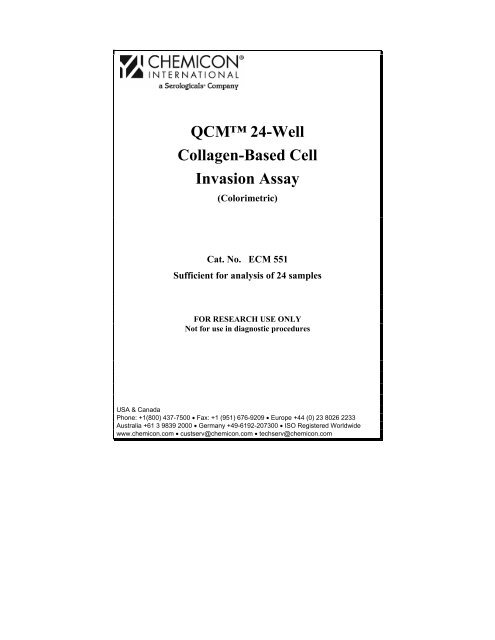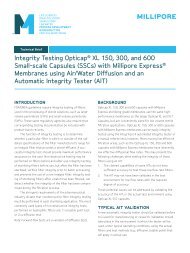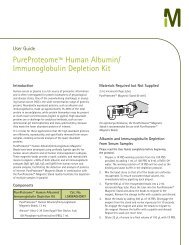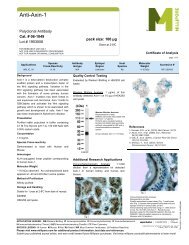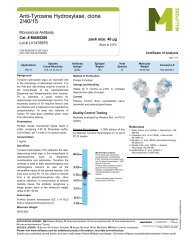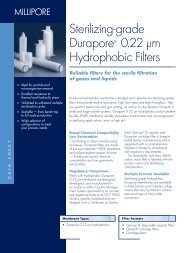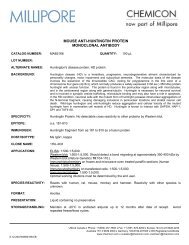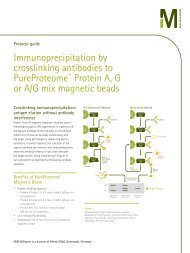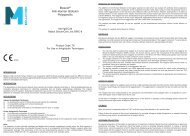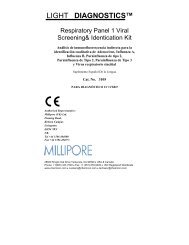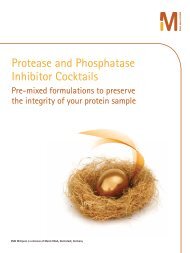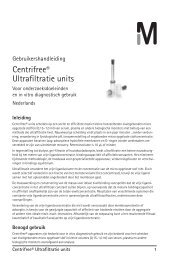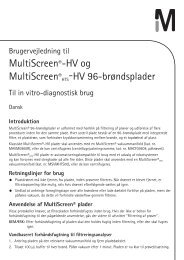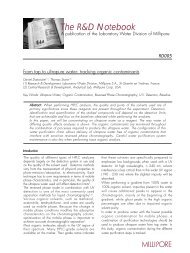QCM™ 24-Well Collagen-Based Cell Invasion Assay - Millipore
QCM™ 24-Well Collagen-Based Cell Invasion Assay - Millipore
QCM™ 24-Well Collagen-Based Cell Invasion Assay - Millipore
You also want an ePaper? Increase the reach of your titles
YUMPU automatically turns print PDFs into web optimized ePapers that Google loves.
QCM <strong>24</strong>-<strong>Well</strong><br />
<strong>Collagen</strong>-<strong>Based</strong> <strong>Cell</strong><br />
<strong>Invasion</strong> <strong>Assay</strong><br />
(Colorimetric)<br />
Cat. No. ECM 551<br />
Sufficient for analysis of <strong>24</strong> samples<br />
FOR RESEARCH USE ONLY<br />
Not for use in diagnostic procedures<br />
USA & Canada<br />
Phone: +1(800) 437-7500 • Fax: +1 (951) 676-9209 • Europe +44 (0) 23 8026 2233<br />
Australia +61 3 9839 2000 • Germany +49-6192-207300 • ISO Registered Worldwide<br />
www.chemicon.com • custserv@chemicon.com • techserv@chemicon.com
This page left intentionally blank.
Introduction<br />
Penetration of the subendothelial basement membrane marks a critical turning<br />
point in the metastatic process. As proliferating neoplastic cells attempt to<br />
escape the primary tumor site, local invasion of the surrounding tissue<br />
(interstitial stroma) must occur. Neovascularization is initiated by expression of<br />
angiogenic factors (e.g. FGF, VEGF, HGF), providing nutritional requirements<br />
and access to the vascular system. Prior to penetrating the blood vessel<br />
endothelium and gaining access to the blood stream (intravasation), cancer cells<br />
must invade local tissues by degrading ECM components and ultimately,<br />
transverse the basement membrane. Once in circulation, these cells can form<br />
metastatic colonies at secondary locations, making this membrane a key<br />
invasive barrier.<br />
The basement membrane surrounding the blood vessel endothelium is a thin,<br />
specialized network of extracellular matrix proteins (ECM) that serves many<br />
functions. Comprised of proteins and proteoglycans, such as collagen, laminin,<br />
entactin, fibronectin, heparin sulfate and perlecan, this membrane acts as a<br />
physical barrier between the epithelium and underlying tissues. It provides cell<br />
surface anchorage (via integrins, receptor kinases, and cell surface<br />
proteoglycans), induces cellular differentiation, gives architectural support, and<br />
limits the migration of normal cells. The ability of tumor cells to degrade the<br />
ECM components of the basement membrane and surrounding tissues is directly<br />
correlated with metastatic potential. By releasing proteolytic enzymes (e.g.<br />
MMP collagenases, plasminogen activators, cathepsins), cancer cells are able to<br />
breach the membrane and penetrate the blood vessel wall. <strong>Collagen</strong>, the<br />
primary structural element of the basement membrane and tissue scaffolding<br />
protein, represents the main deterrent in the migration of tumor cells.<br />
The ability to study cell invasion through a collagen barrier, is of vital<br />
importance for developing possible metastatic inhibitors and therapeutics. The<br />
new CHEMICON QCM <strong>24</strong>-well <strong>Collagen</strong>-based <strong>Invasion</strong> <strong>Assay</strong> (ECM551)<br />
provides an efficient, in vitro system for quantitative analysis of tumor cell<br />
invasion.<br />
The CHEMICON QCM <strong>24</strong>-well <strong>Collagen</strong>-based <strong>Invasion</strong> <strong>Assay</strong> (ECM551)<br />
eliminates cell pre-labeling and manual counting. The <strong>24</strong>-well insert and<br />
colorimetric detection format allows for quantitative comparison of multiple<br />
samples.<br />
1
In addition, Chemicon continues to provide numerous migration, invasion, and<br />
adhesion products including:<br />
• QCM 8µm 96-well Chemotaxis <strong>Cell</strong> Migration <strong>Assay</strong> (ECM510)<br />
• QCM 5µm 96-well Chemotaxis <strong>Cell</strong> Migration <strong>Assay</strong> (ECM512)<br />
• QCM 3µm 96-well Chemotaxis <strong>Cell</strong> Migration <strong>Assay</strong> (ECM515)<br />
• QCM 96-well <strong>Cell</strong> <strong>Invasion</strong> <strong>Assay</strong> (ECM555)<br />
• QCM 96-well <strong>Collagen</strong>-based <strong>Cell</strong> <strong>Invasion</strong> <strong>Assay</strong> (ECM556)<br />
• <strong>24</strong>-well Insert <strong>Cell</strong> Migration and <strong>Invasion</strong> <strong>Assay</strong> Systems<br />
• CytoMatrix <strong>Cell</strong> Adhesion strips (ECM protein coated)<br />
• QuantiMatrix ECM protein ELISA kits<br />
Test Principle<br />
The CHEMICON <strong>Cell</strong> <strong>Invasion</strong> <strong>Assay</strong> is performed in an <strong>Invasion</strong> Chamber,<br />
based on the Boyden chamber principle. Each kit contains <strong>24</strong> inserts; each<br />
insert contains an 8 µm pore size polycarbonate membrane coated with a thin<br />
layer of polymerized collagen. The collagen layer occludes the membrane<br />
pores, blocking non-invasive cells from migrating through. Invasive cells, on<br />
the other hand, migrate through the polymerized collagen layer and cling to the<br />
bottom of the polycarbonate membrane. Invaded cells on the bottom of the<br />
insert membrane are incubated with <strong>Cell</strong> Stain Solution, then subsequently<br />
extracted and detected on a standard microplate reader (560 nm).<br />
2
Application<br />
The CHEMICON <strong>Cell</strong> <strong>Invasion</strong> <strong>Assay</strong> Kit is ideal for evaluation of invasive<br />
tumor cells. Each CHEMICON <strong>Cell</strong> <strong>Invasion</strong> <strong>Assay</strong> Kit contains sufficient<br />
reagents for the evaluation of <strong>24</strong> samples. The quantitative nature of this assay<br />
is especially useful for screening of pharmacological agents.<br />
The CHEMICON <strong>Cell</strong> <strong>Invasion</strong> <strong>Assay</strong> Kit is intended for research use only; not<br />
for diagnostic or therapeutic applications.<br />
Kit Components<br />
1. Sterile <strong>24</strong>-well <strong>Cell</strong> <strong>Invasion</strong> Plate Assembly: (Part No. 90<strong>24</strong>8) Two <strong>24</strong>well<br />
plates with 12 collagen–coated inserts per plate (<strong>24</strong> inserts total/kit).<br />
2. <strong>Cell</strong> Stain: (Part No. 90144) One 20 mL bottle.<br />
3. Extraction Buffer: (Part No. 90145) One 20 mL bottle.<br />
4. Cotton Swabs: (Part No. 10202) 50 each.<br />
5. Forceps: (Part No. 10203) One each.<br />
Storage<br />
Store kit materials at 2-8°C for up to their expiration date. Do not freeze.<br />
3
Materials Not Supplied<br />
1. Precision pipettes: sufficient for aliquoting cells.<br />
2. Harvesting buffer: EDTA or trypsin cell detachment buffer. Suggested<br />
formulations include a) 2 mM EDTA/PBS, b) 0.05% trypsin in Hanks<br />
Balanced Salt Solution (HBSS) containing 25 mM HEPES, or other cell<br />
detachment formulations as optimized by individual investigators.<br />
Note: Trypsin cell detachment buffer maybe required for difficult cell lines.<br />
Allow sufficient time for cell receptor recovery.<br />
3. Tissue culture growth medium appropriate for subject cells, such as DMEM<br />
containing 10% FBS.<br />
4. Chemoattractants (eg. 10% FBS) or pharmacological agents for addition to<br />
culture medium, if screening is desired.<br />
5. Quenching Medium: serum-free medium, such as DMEM, EMEM, or<br />
FBM (fibroblast basal media), containing 5% BSA.<br />
Note: Quenching Medium must contain divalent cations (Mg 2+ , Ca 2+ )<br />
sufficient for quenching EDTA in the harvesting buffer.<br />
6. Sterile PBS or HBSS to wash cells.<br />
7. Distilled water.<br />
8. Low speed centrifuge and tubes for cell harvesting.<br />
9. CO2 incubator appropriate for subject cells.<br />
10. Hemocytometer or other means of counting cells.<br />
11. Trypan blue or equivalent viability stain.<br />
12. Microplate reader (560 nm).<br />
13. <strong>24</strong>-well tissue culture plate.<br />
14. Sterile cell culture hood.<br />
4
<strong>Cell</strong> Harvesting<br />
Prepare subject cells for investigation as desired. The following procedure is<br />
suggested for adherent cells only and may be optimized to suit individual cell<br />
types.<br />
1. Use cells that have been passaged 2-3 times prior to the assay and are 80%<br />
confluent.<br />
2. Starve cells by incubating 18-<strong>24</strong> hours prior to assay in appropriate serumfree<br />
medium (DMEM, EMEM, or equivalent).<br />
3. Visually inspect cells before harvest, taking note of relative cell numbers<br />
and morphology.<br />
4. Wash cells 2 times with sterile PBS or HBSS.<br />
5. Add 5 mL Harvesting Buffer (see Materials Not Supplied) per 100 mm dish<br />
and incubate at 37°C for 5-15 minutes.<br />
6. Gently pipet the cells off the dish and add to 10-20 mL Quenching Medium<br />
(see Materials Not Supplied) to inactivate trypsin/EDTA from Harvesting<br />
Buffer.<br />
7. Centrifuge cells gently to pellet (1500 RPM, 5-10 minutes).<br />
8. Gently resuspend the pellet in 1-5 mL Quenching Medium, depending upon<br />
the size of the pellet.<br />
9. Count cells and bring to a volume that gives 0.5–1.0 x 10 6 cells per mL.<br />
10. If desired, add additional compounds (cytokines, pharmacological agents,<br />
etc.) to cell suspension.<br />
5
<strong>Assay</strong> Instructions<br />
Perform the following steps in a tissue culture hood:<br />
1. For optimal results, bring plates and reagents to room temperature (25°C)<br />
prior to initiating assay.<br />
2. Sterilize forceps with 70% ethanol and handle inserts with forceps.<br />
3. Add 300 µL of prewarmed serum free media to the interior of the inserts.<br />
Allow this to rehydrate the collagen layer for 15-30 minutes at room<br />
temperature.<br />
4. After rehydration from step 3, carefully remove 250 µL of media from the<br />
inserts without disturbing the collagen –coated membrane.<br />
5. Prepare a cell supension containing 0.5-1.0 x 10 6 cells/mL in chemoattractant-free<br />
media.<br />
6. Add 250 µL of prepared cell suspension from step 5 to each insert.<br />
7. Add 500 µL of serum free media in the presence or absence of chemoattractant<br />
(e.g. 10% fetal bovine serum) to the lower chamber.<br />
Note: Ensure the bottom of the insert membrane contacts the media. Air<br />
may get trapped at the interface.<br />
8. Cover plate and incubate for <strong>24</strong> - 72 hours at 37°C in a CO2 incubator (4-<br />
6% CO2).<br />
9. Carefully remove the cells/media from the top side of the insert by<br />
pipetting out the remaining cell suspension, and place the invasion<br />
chamber insert into a clean well containing 400 µL of <strong>Cell</strong> Stain. Incubate<br />
for 20 minutes at room temperature.<br />
10. Dip insert into a beaker of water several times to rinse.<br />
11. While the insert is still moist, use a cotton-tipped swab to gently remove<br />
non-invading cells/collagen layer from the interior of the insert. Take care<br />
not to puncture the polycarbonate membrane. Be sure to remove all cells<br />
on the inside perimeter, as any remaining cells inside the insert will<br />
contribute to background staining. Repeat procedure with a second, clean<br />
cotton-tipped swab.<br />
12. Allow insert to air dry.<br />
6
13. Transfer the stained insert to a clean well containing 200 µL of Extraction<br />
Buffer for 15 minutes at room temperature. Extract the stain from the<br />
underside by gently tilting the insert back and forth several times during<br />
incubation. Remove the insert from the well.<br />
Note: Alternatively, cells can be counted manually through a microscope.<br />
14. Transfer 100 µL of the dye mixture to a 96-well microtiter plate suitable<br />
for colorimetric measurement.<br />
15. Measure the Optical Density at 560 nm.<br />
Calculation of Results<br />
Results of the QCM <strong>24</strong>-well <strong>Collagen</strong>-based <strong>Cell</strong> <strong>Invasion</strong> <strong>Assay</strong> may be<br />
illustrated graphically by the use of a "bar" chart. Samples without cells, but<br />
containing <strong>Cell</strong> Stain and Extraction Buffer are typically used as "blanks" for<br />
interpretation of data. A typical cell invasion experiment will include control<br />
chamber migration without chemoattractant. <strong>Cell</strong> invasion may be induced or<br />
inhibited in test wells through the addition of cytokines or other<br />
pharmacological agents.<br />
The following figure demonstrates typical invasion results. One should use the<br />
data below for reference only. This data should not be used to interpret actual<br />
assay results.<br />
7
OD 560nm<br />
A<br />
B<br />
2.000<br />
1.500<br />
1.000<br />
0.500<br />
0.000<br />
NIH3T3<br />
HT-1080<br />
No Serum 10% Serum 10% Serum<br />
+ GM6001<br />
Figure 1: <strong>Cell</strong> <strong>Invasion</strong> of HT-1080 vs. NIH3T3. HT-1080 and NIH3T3 cells<br />
(+/- 25 µM MMP Inhibitor GM6001) were allowed to invade toward 10% FBS<br />
for <strong>24</strong> hrs. 250,000 cells were used in each assay. A: Invaded cells on the<br />
bottom side of the membrane were stained according to <strong>Assay</strong> Instructions. B:<br />
Colorimetric measurements were taken according to <strong>Assay</strong> Instructions.<br />
8
References:<br />
1. Egeblad M and Werb Z. (2002), New functions for the matrix<br />
metalloproteinases in cancer progression, Nat Rev Cancer 2:161-74.<br />
2. Albini, A., Iwamoto, Y., Kleinman, H.K., Martin, G.R., Aaronson, G.R.,<br />
Kozlowski, J. M., and McEwan, R.N. (1987). A rapid in vitro assay for<br />
quantitating the invasive potential of tumor cells, Cancer Res. 47, 3239-<br />
3<strong>24</strong>5.<br />
3. Repesh, L.A. (1989). A new in vitro assay for quantitating tumor cell<br />
invasion, <strong>Invasion</strong> Metastasis 9, 192-208.<br />
4. Terranova, V.P., Hujanen, E.S., Loeb, D.M., Martin, G.R., Thornburg, L.,<br />
and Glushko, V. (1986) Use of reconstituted basement membrane to<br />
measure cell invasiveness and select for highly invasive tumor cells, Proc.<br />
Natl. Acad. Sci. USA 83, 465-469.<br />
5. Liotta, L.A. (1984) Tumor invasion and metastasis: role of the basement<br />
membrane, Am. J. Pathol. 117, 339-348.<br />
9
Warranty<br />
These products are warranted to perform as described in their labeling and in<br />
CHEMICON ® literature when used in accordance with their instructions.<br />
THERE ARE NO WARRANTIES, WHICH EXTEND BEYOND THIS<br />
EXPRESSED WARRANTY AND CHEMICON ® DISCLAIMS ANY<br />
IMPLIED WARRANTY OF MERCHANTABILITY OR WARRANTY OF<br />
FITNESS FOR PARTICULAR PURPOSE. CHEMICON ® ’s sole obligation<br />
and purchaser’s exclusive remedy for breach of this warranty shall be, at the<br />
option of CHEMICON ® , to repair or replace the products. In no event shall<br />
CHEMICON ® be liable for any proximate, incidental or consequential damages<br />
in connection with the products.<br />
©2003: CHEMICON ® International, Inc. - By CHEMICON ® International, Inc.<br />
All rights reserved. No part of these works may be reproduced in any form<br />
without permissions in writing.<br />
Cat. No. ECM551<br />
May 2003<br />
Revision A: 41402


